In 1955, the landscape historian W.G. Hoskins urged readers of The Making of the English Landscape to turn away from the militarised and industrialised countryside of the present and ‘contemplate the past before all is lost to the vandals’. The sense that rural England was fatally threatened by modernity had deeper roots, however: the decline of the agricultural economy had been exacerbated by the repeal of the Agriculture Act in 1921, while the broader societal changes that followed the First World War made the fate of the English countryside a matter of deep concern for many interwar artists and writers. This concern continues today: in January this year, the exhibition ‘The Land We Live In – The Land We Left Behind’ opened at Hauser & Wirth Somerset (until 20 May), aiming to explore ‘the contradictory nature of society’s relationship to the rural’.
The antiquarianism that inflected the work of artists like Paul Nash, John Piper and Barbara Hepworth throughout the 1930s shows the double edge of a rural preservationist impulse. On the one hand, photography and film could reveal ancient features of the landscape as quintessentially modern: this is the case in Nash’s photograph of the White Horse of Uffington, for example, which is rendered in serpentine abstraction, or the way in which Dudley Shaw Ashton’s film Figures in a Landscape (1953) juxtaposed the Neolithic Mên-an-Tol standing stones with Hepworth’s sculpture Forms in Echelon (1938). On the other hand, these same ancient features were evanescent and vulnerable: the archaeologist O.G.S. Crawford used the pages of his journal Antiquity, which featured aerial photographs revealing the ‘shadow sites’ of ancient henges and Roman camps, to decry the ‘demands of the Services for land for aerodromes and manoeuvres, [and] the spread of bungaloid eruptions’, the developments threatening to permanently erase these forms which the currents of modernity had so recently revealed.
The White Horse, Uffington, Berkshire (date unknown), Paul Nash. Tate, London
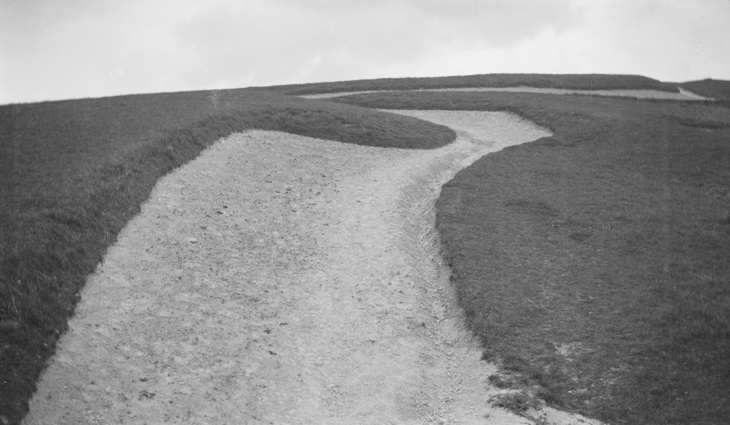
Kitty Hauser has made the case that photography was an integral part of a great, unfinished project for Crawford, in which the accumulated records of the past would at some point coalesce to reveal the grand pattern of history. But the majority of the personal archive he had assembled while Archaeology Officer at the Ordnance Survey was destroyed in a bombing raid in November 1940; for many others, with the outbreak of the Second World War, the act of preservation began to feel more and more like a process of salvage, of making a record before all was lost. The ‘Recording Britain’ project, which employed nearly 100 artists under the direction of Kenneth Clark, resulted in more than 1,500 watercolours and drawings carried out in just three years. The first places recorded were the towns and villages of southern England, at greatest risk of aerial bombardment, but the remit was later expanded to include many more rural areas considered to be at risk from ‘improvers and despoilers’.
Perhaps unsurprisingly, this artistic salvage operation gathered countryside tithe barns, county town almshouses, and details of stately homes and churches. But it also picked out less predictable features of rural and small town life, from Barbara Jones’s paintings of fairground equipment in King’s Lynn and the life-size black bear that marks the pub of the same name in Wareham, to Thomas Hennell’s depictions of rural craft and labour. Hennell drew wheelwrights, blacksmiths, potters and sheep shearers, all in their working environments, and in doing so placed their practices on the same level as Tudor manor-houses and Regency shopfronts: all were endangered, and all were worthy of recording. Even before his wartime work, Hennell had collaborated with the writer H.J. Massingham to illustrate Country Relics (1939), an elegiac book based on the latter’s collection of near-obsolete tools for thatching, lace-making, basketry and more.
Sheep shearing, Godmanstone, from the ‘Recording Britain’ project (1940), Thomas Hennell. Victoria and Albert Museum, London
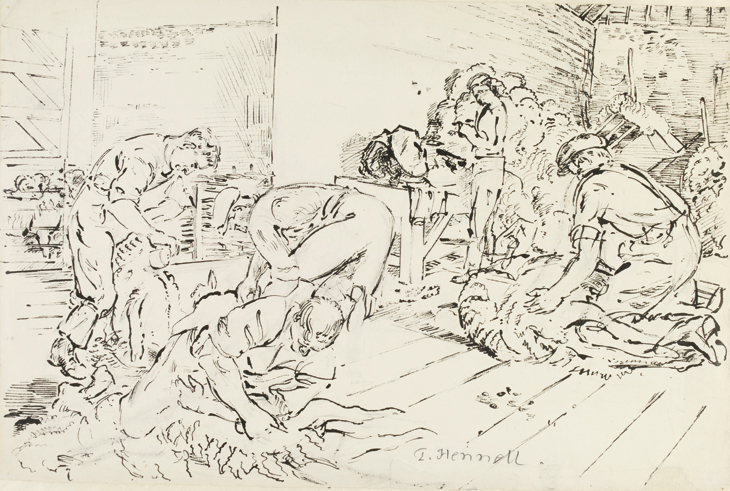
The term ‘relics’ here performs the double function of firmly situating the countryside and its rural practices as already lost to the past, while imbuing these workaday objects, such as shears and bradawls, with a quasi-religious significance, as points of material connection to a supposedly more authentic way of living. The impulse to seek out rural artefacts as markers of the past can also be seen in the establishment of organisations such as the Museum of English Rural Life, which began as a travelling exhibition, touring agricultural shows and amassing a collection of farm machinery rendered obsolete by advances in production methods. After its peripatetic beginnings, the museum officially opened at the University of Reading in 1951. This was the year of the Festival of Britain, an event in which the country’s agricultural past and a modernist, largely urban vision of its future were forced into an uneasy celebration of national identity. This was perhaps most vividly enacted in the Lion and Unicorn Pavilion, an impressive steel-framed construction designed by R.D. Russell and Robert Goodden. Within its modernist interior could be found an almost life-sized rendering of these emblematic beasts made out of straw by Fred Mizen, a gardener from the village of Great Bardfield in Essex, who was famous for his skill as a maker of corn dollies.
Today, anxieties around change and development continue to define our relationship to the countryside and the impulse to record rural life remains strong. Contemporary artists Antje Schiffers and Thomas Sprenger, working as part of the collective myvillages, have been engaged in a long-term project called I like being a farmer and I would like to stay one (2000–present). Their aim is to collect short documentary films about what it is like to be a farmer today in the UK, Europe and Africa. What is unusual about this venture is that the farmers make the films themselves, selecting what they think is important about their working practices and recording their own experiences. The project revolves around a novel exchange of labour: while the farmers make the films, the artists paint a landscape of the farm, working en plein air with easel and brushes. The farmers choose the location depicted in the painting, and keep the artwork at the end of the collaboration.
Scything, Tinker’s Bubble from the project GB Farming (2007), Georgina Barney. Courtesy Georgina Barney
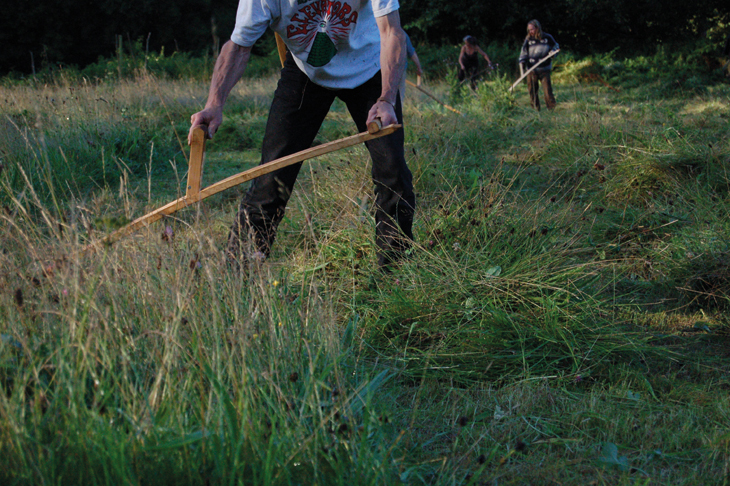
In her project GB Farming (2007), Georgina Barney worked on 14 farms over a period of eight months. Travelling from the Highlands of Scotland to Cornwall, she recorded her experiences in a series of blog posts and drawings, recently published as the book GB Farming: An Island Journey (2017). Among Barney’s accounts of the physicality of the farming work, the cold showers and early starts, and her felt-tip drawings of sunrise colours reflected in the black plastic wrap of silage bales, we get a sense of the variety of contemporary farming in the UK. We are taken from a family-owned sheep farm to Tinker’s Bubble – a radical community living off the land without the use of fossil fuels, scything grass meadows by hand – to agribusiness units in East Anglia with 4,000 employees. The current uncertainty around the UK’s exit from the European Union and its effect on agricultural subsidies and migrant labour, together with shifting climate patterns resulting in droughts and flooding, means that contemporary projects like these follow their predecessors in recording farming life at yet another period of significant transition, and arguably of crisis.
A different way to counter the apparent loss of rural landscapes and ways of life is not to preserve and record but to reclaim and renew. ‘Back to the land’ has long been a cry taken up by both progressives and reactionaries, and in the politically polarising years of the 1930s these positions were sometimes difficult to disentangle. The figure of Rolf Gardiner illustrates this: as the instigator of a thoroughgoing programme of rural revival, both cultural and agricultural, from his Dorset estate of Springhead, and as one of the post-war founders of the Soil Association, he is remembered as a pioneer of organic farming. However, his alignment with far-right and anti-Semitic groups such as the English Mistery and the English Array, and his early appreciation of National Socialism (he wrote to Joseph Goebbels in 1933, and the same year defended Nazi persecution of the Jews in a letter he attempted to publish in The Times), places him undeniably in the camp of far-right fellow-travellers.
In England Herself: Ventures in Rural Restoration (1943), Gardiner despaired of the ‘barren verse of our so-called poets’, concluding that art could not be ‘divorced from the soil’. His ‘rural university’ tried to reconnect art forms like music and folk dance to the rhythms of communal work and to the seasons, as his annual Harvest Camps brought together young people from across national, regional and class divides to labour in the fields, listen and debate, dance and sing. German hymns, masses by Byrd and polyphonic folk songs were all art forms with an instructional purpose, leading the participants to a vision of life based on connection to the land and obedience to a greater order. Internationalist by background and inclination, Gardiner had fallen in love with the German youth movements of the 1920s, seeing Springhead and its equivalents across Northern Europe as monasteries incubating a new, organic culture during Europe’s mechanised Dark Ages. Gardiner may have been grasping at straws in an attempt to see National Socialism as a fulfilment of the youth movements rather than their betrayal, but his trajectory provides a sobering reminder of the way dreams of rural reclamation have veered dangerously close to fascist ideologies of ‘blood and soil’.
Women evacuated to Oakley Farm at Bromley from the Pioneer Health Centre, Peckham, during the Second World War, 1940s. Wellcome Collection, London. Reproduced by permission of the Pioneer Health Foundation
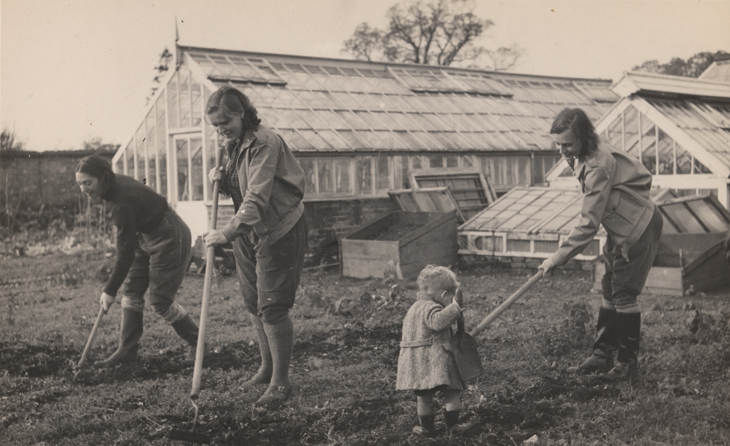
A more hopeful, if less notorious, venture into rural renewal can be found through the work of another founder member of the Soil Association, Innes Pearse. Pearse was a doctor and co-creator of the Pioneer Health Centre, set up in Peckham during the 1930s to explore human health in its fullest environmental context. In September 1939, with evacuation from London a priority, Pearse organised for 30 Peckham mothers with young children to move to Oakley Farm, a few miles outside the city, where they divided their time between agriculture, communal cooking and childcare. While this small-scale ‘Homestead Scheme’ was undoubtedly a cultural enterprise as much as a farming one, it generated little visual material beyond its archival photographs. However, when the wartime state led a mass mobilisation of female labour on to the land, in the form of the Women’s Land Army, it commissioned war artists to document their work. Evelyn Mary Dunbar’s paintings for the War Artists’ Advisory Committee largely focused on ‘Land Girls’; her work, A 1944 Pastoral: Land Girls Pruning at East Malling
(c. 1944), with its detailed border of gloved hands demonstrating the use of pruning saws and secateurs, and its central panel of women tending to rows of apple trees that march into the distance, provides a counterpoint to the masculine ‘husbandry’ and anti-urbanism favoured by the likes of Gardiner.
A 1944 Pastoral: Land Girls Pruning at East Malling (c. 1944), Evelyn Mary Dunbar. Manchester Art Gallery. Courtesy Manchester Art Gallery, UK/Bridgeman Images; © Evelyn Dunbar Estate
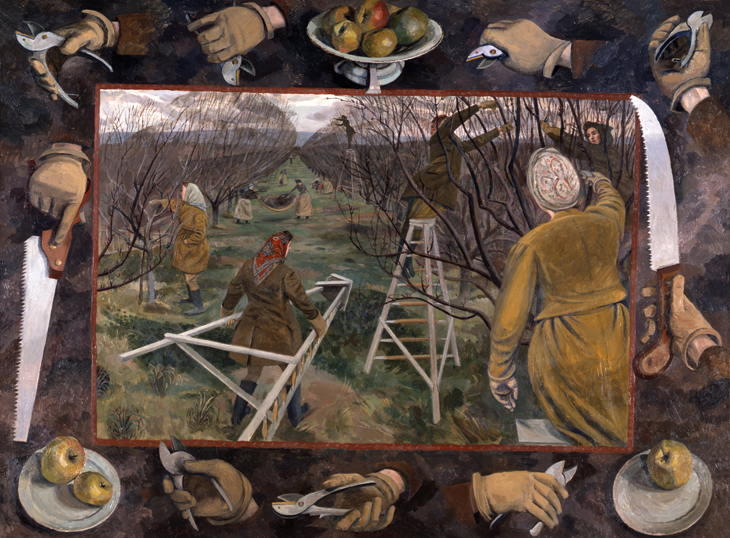
The ‘Homestead Scheme’ and Women’s Land Army were catalysed by war, and contemporary visions of rural utopia have often imagined similarly apocalyptic events to effect dramatic shifts away from consumer-driven lifestyles in urban centres. The cultural critic Fredric Jameson wrote that ‘someone once said it is easier to imagine the end of the world than to imagine the end of capitalism’, and increasingly, artists are imagining a near future where the realities of climate change require a re-evaluation of capitalist relationships to the land. In 2014, Paul Chaney initiated a three-year research project which imagined how the Lizard Peninsula in Cornwall could continue to support its present-day population in a situation of self-sufficient, fossil fuel-free isolation. Like Hoskins, Crawford and Nash before him, Chaney traces the marks left upon the landscape by older ways of living. His Lizard Exit Plan includes the reopening of 19th-century clay pits and medieval peat workings mapped out in a series of photographs and drawings. However, the plan also considers how to repurpose more modern technologies rendered obsolete in an unfamiliar future, such as the salvage of aluminium from abandoned planes at Predannack Airfield, and the conversion of a satellite dish at Goonhilly Earth Station into a parabolic solar concentration device for reprocessing metals. As part of the project, Chaney built Encampment Supreme, an impressive 775-square-foot pavilion, using post-consumer waste products and locally found natural elements. Here, he hosted a series of critical conversations and workshops exploring alternative ways of living.
Today, interest in the relationship between art and rural life shows no signs of abating: two recent exhibitions have brought together historical and contemporary works of art in an attempt to connect some of the lines of thought about the countryside and its attendant anxieties of preservation, development and renewal. In 2017, Compton Verney hosted ‘Creating the Countryside: Thomas Gainsborough to Today’ which aimed to move beyond a simple critique of the romanticised pastoral image, and instead ask how these images are re-enacted, adapted or contested today. One work featured in this exhibition was a large-scale watercolour by Edward Burra called An English Country Scene No.2 (1970). It shows a long queue of cars, lorries and motorbikes snaking through a spectacular hilly landscape, bringing to mind the contradictions of seeking escape in the great outdoors and the ways in which tourism both encourages and impedes preservation in rural places. This painting was shown with Rebecca Chesney’s Map. Volume 1, Coniston (2005–06), a drawing of the Lake District which charts the network of boundaries that invisibly criss-cross this apparently ‘natural’ landscape. The piece shows how the area is delineated by the concerns of 45 different organisations ranging from local authorities, to the National Trust, to the Arts Council, together with different land classifications including areas which had been designated as Sites of Special Scientific Interest. The map becomes a complicated and indecipherable drawing offering another perspective on this landscape.
Tightening up the Green Belt (c. 1935–47), William Heath Robinson. Drawing Matter, Shatwell Image courtesy Drawing Matter Collections
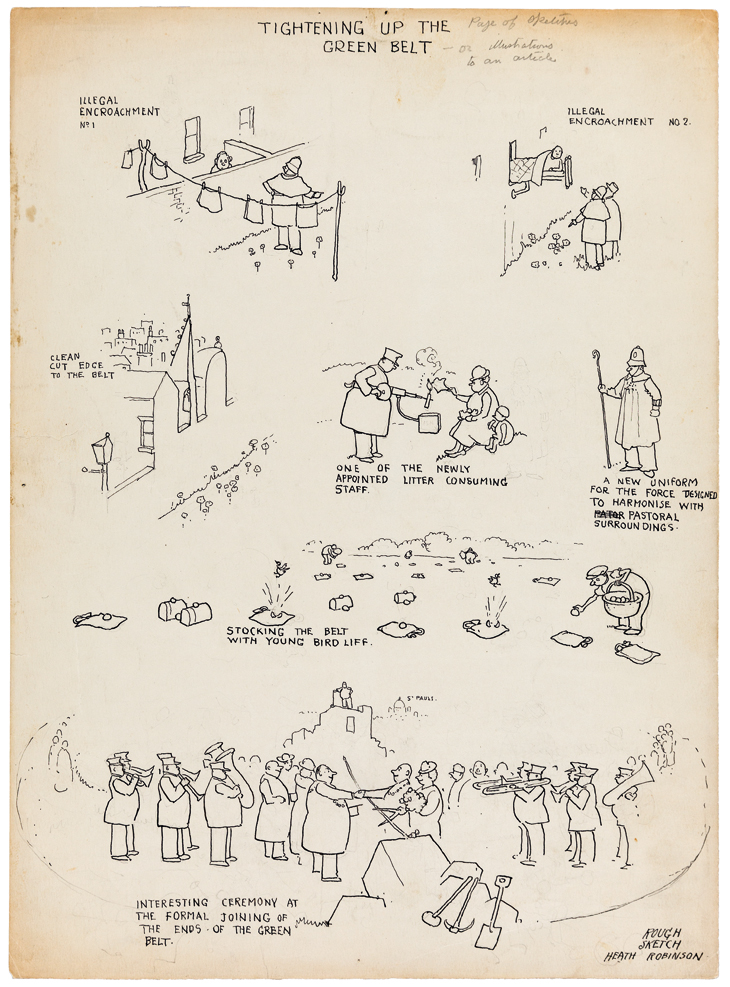
In Hauser & Wirth’s current show, curated by Adam Sutherland of Grizedale Arts, the forces of conservation and reclamation are particularly evident in a section called ‘Rural Revolutions’. Here we find, among a tremendous collection of archival objects and artworks, a drawing by Beatrix Potter. Not, as one might expect, one of her illustrations of winsome anthropomorphised animals, but a delicate rendering of the Absidia fungus, which she made in 1897 for a learned journal. Potter was a resident of the Lake District, and devoted herself to campaigning on local conservation issues. She also worked with the National Trust to acquire a significant amount of land in the area, with a view towards preserving traditional land use and management. Displayed close to Potter’s drawing, a cartoon by William Heath Robinson satirises the impulse to preserve the landscape, whether undertaken by individuals like Potter, large organisations like the National Trust, or even by the government. Tightening up the Green Belt (c. 1935–47) shows a number of absurd imaginary consequences of the enforcement of new planning regulations to curb housing developments in rural places, including a policeman sporting a new pastoral uniform of smock and shepherd’s crook. As the English countryside enters a newly ‘post-agricultural’ era, this image feels like a timely reminder of the way in which claims to preserve or revitalise rural life can make a handy cloak for those wishing to impose their authority on it.
Rosemary Shirley is Senior Lecturer in Art History at Manchester Metropolitan University and co-editor of Creating the Countryside: The Rural Idyll Past and Present (Paul Holberton). James Wilkes is a writer of poetry and fiction, and author of A Fractured Landscape of Modernity (Palgrave Macmillan).
From the April issue of Apollo. Preview and subscribe here.


